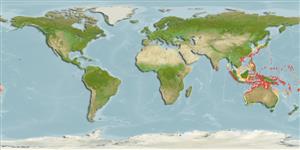>
Eupercaria/misc (Various families in series Eupercaria) >
Scaridae (Parrotfishes) > Scarinae
Etymology: Scarus: Greek, skaros = a fish described by anciente writers as a parrot fish; 1601 (Ref. 45335); fuscocaudalis: Named in reference to the dark color of the large central portion of the caudal fin of the initial phase (Ref. 40928).
More on authors: Randall & Myers.
Environment: milieu / climate zone / depth range / distribution range
Écologie
marin récifal; profondeur 20 - 45 m (Ref. 90102). Tropical
Indo-West Pacific: Ryukyu Islands, Philippines, and Guam. Records from Indonesia and Papua New Guinea are questionable and confirmation is needed.
Taille / Poids / Âge
Maturity: Lm ? range ? - ? cm
Max length : 25.0 cm TL mâle / non sexé; (Ref. 48636)
Description synthétique
Morphologie | Morphométrie
Épines dorsales (Total): 9; Rayons mous dorsaux (Total): 10; Épines anales 3; Rayons mous anaux: 9; Vertèbres: 25. Presence of 4 median predorsal scales; 3 rows of scales on cheek, the upper row with 6-7 scales, the middle row with 6 scales, and the lower row with 1 or 2 scales; 1 or 2 laterally projecting canines posteriorly on side of dental plates of adults; lips covering more than 3/4 of dental plates; dorsal fin moderately high, the longest dorsal spine 2.1-2.6 in head length; caudal fin truncate in young, double marginate in initial-phase fish, and somewhat lunate in terminal males. Initial phase fish brownish pink to rose pink, the throat and thorax green with green stripes extending posteriorly across abdomen; naked part of caudal fin blackish with orange lobes and a broad whitish posterior margin; body of terminal males pink and green, with blue and pink stripes ventrally; head blue with pink stripes ( a broad one on snout passing through lower eye to pectoral-fin base, and another from behind eye across upper part of operculum); naked part of caudal fin purple centrally, green posteriorly, the lobes blue with a pink submarginal band.
Found in coastal to outer reef crests and along drop-offs, usually in small groups (Ref. 48636); occurs at depths greater than 20 m (Ref. 40928).
Life cycle and mating behavior
Maturité | Reproduction | Frai | Œufs | Fécondité | Larves
Oviparous, distinct pairing during breeding (Ref. 205).
Parenti, P. and J.E. Randall, 2000. An annotated checklist of the species of the labroid fish families Labridae and Scaridae. Ichthyol. Bull. J.L.B. Smith Inst. Ichthyol. (68):1-97. (Ref. 35918)
Statut dans la liste rouge de l'IUCN (Ref. 130435)
Menace pour l'homme
Harmless
Utilisations par l'homme
Plus d'informations
PaysZones FAOÉcosystèmesOccurrencesIntroductionsStocksÉcologieRégime alimentaireÉléments du régime alimentaireConsommation alimentaireRation
Taille/ÂgeCroissanceLongueur-poidsLongueur-longueurFréquences de longueursMorphométrieMorphologieLarvesDynamique des populations larvairesRecrutementAbondanceBRUVS
RéférencesAquacultureProfil d'aquacultureSouchesGénétiqueElectrophoresesHéritabilitéPathologiesTraitementNutrientsMass conversion
CollaborateursImagesStamps, Coins Misc.SonsCiguateraVitesseType de nageSurface branchialeOtolithesCerveauxVision
Outils
Articles particuliers
Télécharger en XML
Sources Internet
Estimates based on models
Preferred temperature (Ref.
123201): 24.4 - 28.5, mean 27.4 °C (based on 70 cells).
Phylogenetic diversity index (Ref.
82804): PD
50 = 0.5000 [Uniqueness, from 0.5 = low to 2.0 = high].
Bayesian length-weight: a=0.01023 (0.00436 - 0.02401), b=3.09 (2.90 - 3.28), in cm total length, based on LWR estimates for this Genus-body shape (Ref.
93245).
Résilience (Ref.
120179): Haut, temps minimum de doublement de population inférieur à 15 mois (Preliminary K or Fecundity.).
Fishing Vulnerability (Ref.
59153): Low vulnerability (15 of 100).
Nutrients (Ref.
124155): Calcium = 62 [35, 108] mg/100g; Iron = 0.828 [0.529, 1.410] mg/100g; Protein = 18 [16, 20] %; Omega3 = 0.0631 [, ] g/100g; Selenium = 22.8 [11.3, 42.2] μg/100g; VitaminA = 52.1 [13.0, 208.3] μg/100g; Zinc = 2.63 [1.86, 3.63] mg/100g (wet weight);
